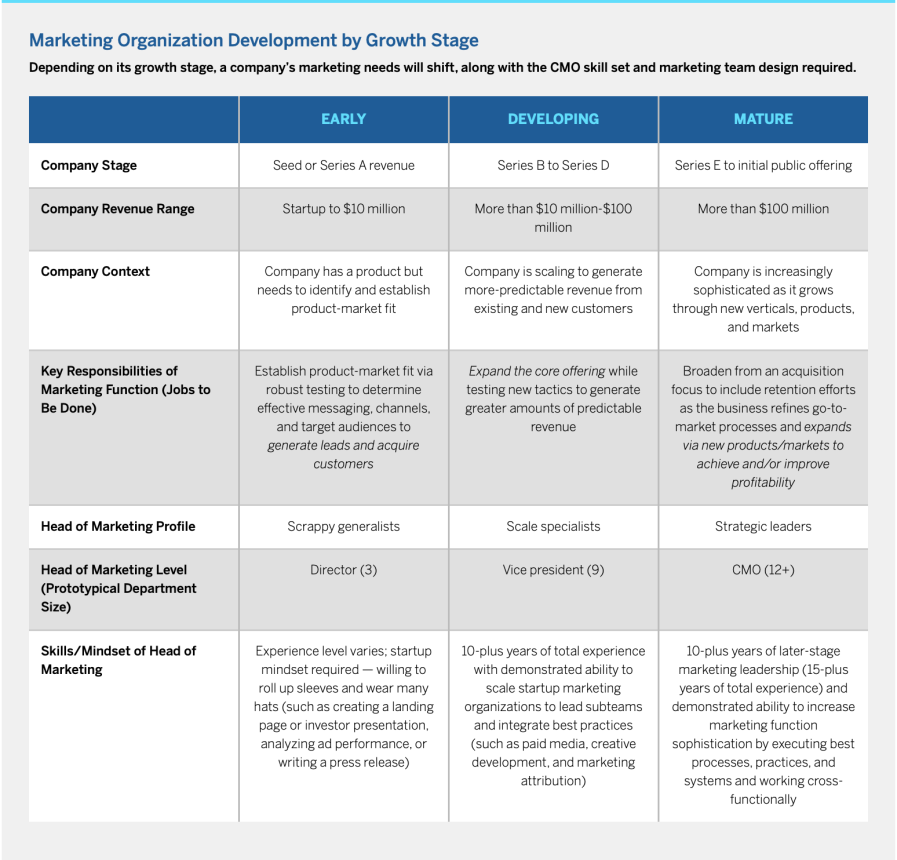Design Your Marketing Organization to Fit Your Company’s Growth Stage
An early-stage company requires a different organizational structure than a mature one. Marketing leaders must adapt their teams and strategies accordingly.
Topics
News
- AI-Driven Scams Surge as Microsoft Blocks $4 Billion in Fraud Attempts
- Identity-based Attacks Account for 60% of Leading Cyber Threats, Report Finds
- CERN and Pure Storage Partner to Power Data Innovation in High-Energy Physics
- CyberArk Launches New Machine Identity Security Platform to Protect Cloud Workloads
- Why Cloud Security Is Breaking — And How Leaders Can Fix It
- IBM z17 Mainframe to Power AI Adoption at Scale

Carolyn Geason-Beissel/MIT SMR
Determining the optimal design of a department or function is a key aspect of organization design and one of the most important decisions C-level executives make. Organization design establishes the essential infrastructure that enables or hinders companies’ effective deployment of strategic decisions, yet it is one of the least studied and understood by business leaders. Typically, leaders find themselves contemplating restructuring for the first time in their careers after being promoted to an executive level and facing an organizational problem that needs urgent attention. It takes adeptness for an executive to even recognize that they have a structural design problem rather than a staffing issue.
Consequently, one of the most significant challenges CMOs face is figuring out how to configure the marketing organization to achieve their company’s goals and objectives, especially when it is pursuing or experiencing rapid growth, as in the case of an early-stage startup. A recurring question we’ve gotten from CMOs and CEOs is how to structure a marketing organization to accelerate growth. As we looked for answers to this question, we realized that few existed and none had the specificity to provide insights at different stages of company growth.
To address this common yet poorly understood issue, we conducted primary research designed to understand marketing organization design at different growth stages and identify the traps that impair marketing success. The research included interviews with 100 CMOs from companies at different growth stages to provide specific insights on the organizational structure and marketing leadership requirements businesses experience as they go from Series A to IPO.
The Marketing Organization Development Stages
The structure of a marketing department requires continual reevaluation and revision as a company grows. A key question is when such transitions should occur. In our interviews with marketing leaders, they consistently expressed difficulty understanding when to shift the structure of the organization and what it should shift to. As a company’s stages of growth change, the type of marketing it does shifts; as a result, crucially, there is a requisite shift in the department’s structure and in the skills and abilities that employees, including the CMO, must have.
Across our interviews, we observed a pattern that highlights three key stages of marketing organization development that align with company size: early (no revenue to $10 million) to developing (more than $10 million to $100 million) to mature(more than $100 million). We found that at each level of revenue development, departmental needs and structures experienced a step-function shift in (1) company context, (2) the marketing “jobs to be done,” (3) the type of marketing skills and experience required, and (4) the type of structure that reflects these conditions. The table below highlights key changes in the design, structure, staffing, and jobs to be done by each stage.

At the early stage, companies are trying to identify a product-market fit and generate early revenue. Companies are relatively unstructured, so the CMO’s job is to be an entrepreneurial, scrappy generalist focused on customer acquisition. At this stage, the CMO must have a facility to lead and “do”— to roll up their sleeves and get hands-on work done.
At the developing stage, companies have successfully identified product-market fit, have demonstrated their proof of concept by developing a revenue stream, and now seek to scale. CMOs must be scale specialists who augment the activities of the earlier stage with more specialized expertise, such as engaging in customer life cycle marketing and establishing strategic partnerships, to create more predictable and efficient revenue. There is an emerging need to develop systems to establish a more detailed understanding of performance, including attribution models and new marketing technology.
At the mature stage, companies need a CMO who’s a strategic leader with greater expertise at driving growth through cross-functional alignment and innovation. Given that at this stage, the governance of the company is often increased (through a board and CEO oversight, for instance), CMOs must be adept at managing up the organization as well as across and down. This requires more executive-level communication, sophisticated measurement and reporting systems, tighter definitions for team roles and responsibilities, and more strategic and longer-term thinking. The CMO shifts from being a functional player to more of a coach and conductor, helping to facilitate the work of the organization.
Three Traps in Designing Marketing Organizations
A common theme in our interviews was that the transition across stages is fraught with peril. The following three traps can ensnare marketing department organization design.
Trap 1: Missing the shift. As the needs of the organization shift, the marketing organization must adapt as well. Lack of awareness that a shift is occurring and that a new organization design is required can catch less-experienced CEOs and CMOs flat-footed. The consequence is that the marketing department is not delivering the value that the organization needs as it stays rooted in processes, systems, and capabilities of the past.
How to avoid the trap: We found that CMOs who avoided this trap had heightened awareness of the importance of organization design. They tended to have plans and structures already created, on paper, and proactively discussed them with the CEO. One CMO suggested connecting the goals and strategies of the company’s strategic plan to the organization design and recommended that CMOs update the design as they develop their strategic plan or annual KPIs. This forces the discipline of reconsidering organization design when designing strategic plans.
Trap 2: Not staying ahead of the firm’s growth. Early-stage companies often face more-accelerated growth. As David Minifie, former chief experience officer and executive vice president of corporate strategy at managed care company Centene, told us, “Because we grew more than seven times in nine years, I had been in a constant cycle of new org design, implementation, new org design, implementation, and so on.” One challenge in early-stage, high-growth companies, then, is staying ahead of the organization design and staffing required. Some CMOs described the challenge as having difficulty “maintaining progress on day-to-day work” while also trying to perpetually redesign, recruit, and staff the organization. This required early-stage CMOs to do double the work as they delivered output while preparing for the future.
How to avoid the trap: There were a few approaches that CMOs took to address this problem. One was to outsource this work to executive search firms. Other CMOs took the responsibility on themselves and found that it was a struggle to prioritize tomorrow’s organization design over today’s urgencies. Those who were successful at staying ahead of organization design needs knew that they had to make recruiting the No. 1 priority. They offloaded other work to team members or put in extra hours — which isn’t unusual in early-stage, high-growth companies — to handle the additional burden of staffing the organization while also trying to execute a plan.
Trap 3: Believing that effective early-stage CMOs will be equally effective at the developing and mature stages. Individual CMOs often excel at different stages of growth. Somebody who is adept at operating in a lean, speed-oriented, less routinized environment requiring hands-on engagement (such as in the early stage) is not necessarily as comfortable or effective working in an environment that requires more process, approvals, and hands-off leadership. While training and development can help prepare CMOs to grow with the company, it’s important that they be honest with themselves about whether they will want to make the changes necessary to be effective at different stages.
Moreover, we talked with executive recruiters who indicated that this skill gap can occur across growth stages — that is, CMOs from more mature organizations might not be best equipped to lead at developing organizations. For example, a CMO from a large, respected training company might believe that their experience has more than prepared them to lead marketing at a startup, and the startup CEO might believe that such a well-trained CMO is more than capable of helping steward a startup marketing organization. However, CMOs from mature companies often have legions of teams who do a lot of the work, and so they might be less aware and less capable of managing the day-to-day, roll-up-your-sleeves tasks that a startup requires. They also might tend to require big budgets to get work done or to create project timelines that don’t prioritize speed over perfection.
How to avoid the trap: CMOs who were more experienced and honest about their strengths and preferences seemed to be happier and more comfortable with their circumstances. One way for CMOs to avoid misplaced confidence is to document their strengths and preferences and compare them with the type of CMO that their organization needs at the current stage of development. If there are gaps, CMOs can seek a better-fitting role or be honest about their weaknesses and recommend ways to address them, including receiving additional training and hiring new team members who can fill skill gaps. Additionally, CEOs can prioritize and value candidates who have demonstrated success in the role requirements for a company of similar size rather than some other qualification. For example, while big-company experience is impressive, an early-stage CEO should ensure that CMO candidates have proven success operating in a startup environment.
Organization design and staffing decisions are among the most important choices an executive makes in terms of driving outcomes, but they are often poorly understood. Marketing organization design isn’t a subject typically researched in academia or taught in undergraduate, graduate, or even executive education classes. With little insight or guidance available, it remains a significant issue that CEOs and CMOs are struggling to figure out. Our research provides insights on the attributes of marketing organizations at different growth stage levels while enabling leaders to avoid the all-too-common traps that prevent success.





